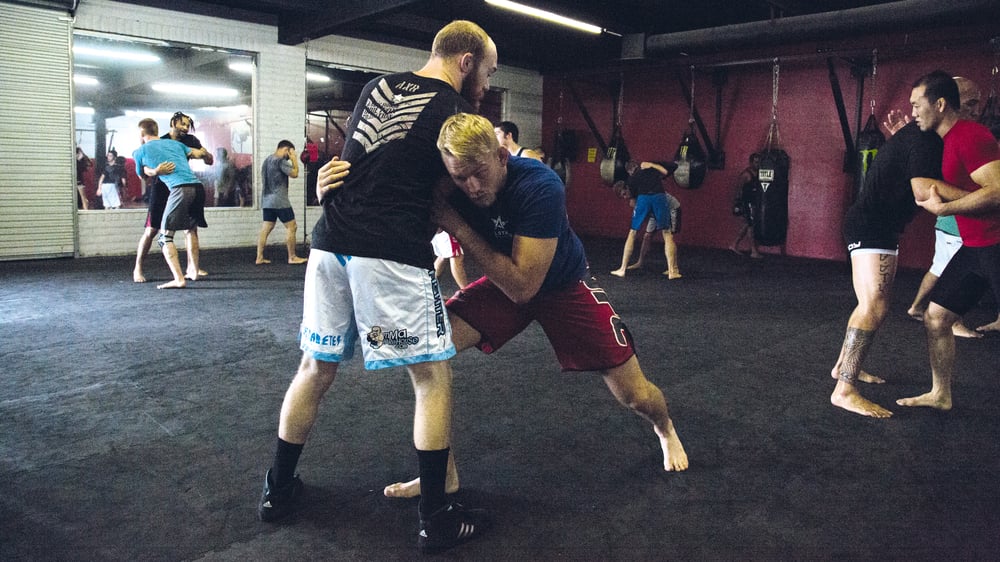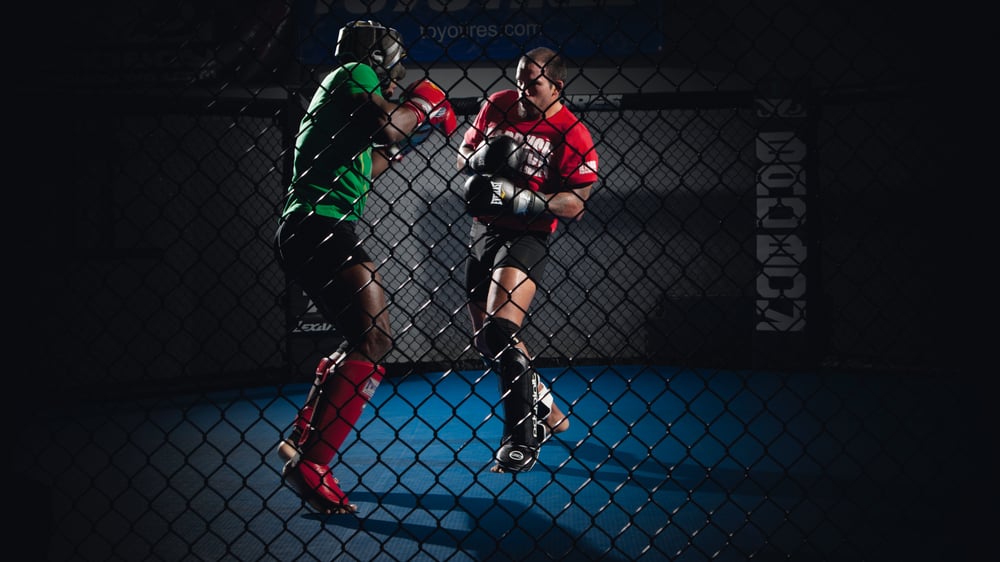
Issue 108
December 2013
Behind every MMA champion is a dedicated team of sparring partners willing to put their bodies on the line without giving a thought to glory. But what drives them to do it? And what does it take to earn the respect of a belt-wearer they’re paid to push to the limit on a daily basis?
Most people who put on a pair of mixed martial arts gloves will never become full-time professional fighters. Injuries, age, work and family commitments, and a thousand other factors can curtail competitive careers. Fortunately, there is still a way for anyone with the right amount of will and skill to become a vital cog in the machinery of a successful fighter factory.
Good sparring partners are as important to a gym as mats, bags and showers. Behind the big names there is usually a squad of hard-training and highly skilled martial artists who you’ve never heard of. Some with no pro record.
Coaches get to share in some of the reflected glory of top fighters, becoming famous in their own right and even vying for Fighters Only ‘Coach of the Year’ awards, but the training partners who sweat and bleed for every fighter’s victory remain MMA’s unsung heroes.
Recently retired former UFC lightweight champion Sean Sherk insists his success would not have been possible without the right help.
“They were super important,” he tells Fighters Only. “I couldn’t have done it without them. For many years I was the only pro fighter at the gym. Guys would show up every day, several times a day, to help me out.”

It was during those early days that Sherk learned that the hours put in by training partners extended far beyond their time on the mat.
“Black and brown belt Brazilian jiu-jitsu guys, kickboxers, they’d watch videos of my opponents without being asked. They’d come in and they’d have done breakdowns from a BJJ perspective or a kickboxing perspective and help me out with game plans.”
Almost a decade and a half on from Sherk’s MMA debut, the need to bring brains as well as brawn to a pro camp is echoed by up-and-coming lightweight prospect Dan Moret.
Dan’s 5-0 record and time training alongside Sherk at The Academy in Minnesota under head coach Greg Nelson led to him being flown to San Diego by Alliance MMA to spar and train with Myles Jury ahead of his UFC debut against Mike Ricci in September.
“I did some research and watched several of Ricci’s fights as well as Myles’s fights so I could best imitate his opponent and then give him some advice on what I thought he could do,” Dan reveals.
“Obviously, he has coaches who give him his game plan but I just want to give him insight as a taller, left-handed fighter into what I would do if I were fighting him. My input comes in at the end.
“There are sometimes things that I can see as a fighter that maybe his coaches can’t because they’re looking at it from a different perspective.”
Greg Nelson himself knows how important sparring partners have been to securing UFC gold for Sean Sherk, Brock Lesnar and Dave Menne, but what motivates them?
“I’ve had a few guys that could push some of my best fighters, but never wanted to fight. They simply loved to push themselves and help the fighters,“ reveals Greg.
“I had one guy who was a beast, a three-time Division III NCAA wrestling champion. He was not only extremely technical, he was physically one of the strongest guys on the mats. Being a high-level wrestler he knew how to push himself and everyone around him hard.
“The first day he was in The Academy he took down Sean Sherk six times in a row. He was just wrestling, not trying to prove anything. Sean immediately said,
‘We have to keep this guy,’ and he became one of Sean’s regular training partners.
“But he insisted that with a successful wrestling career behind him and a six-figure job he didn’t have the drive to give it up to become an MMA champion.”

SUPER SPAR
Do you want to learn how to be a world-class training partner? Coach Greg Nelson, former UFC champ Sean Sherk and pro sparring partner Dan Moret provide their top tips.
CHECK YOUR EGO
Greg: “A great sparring partner has all the attributes of a great fighter, however, they understand that the fighter is in the spotlight. This requires confidence in yourself and your role. A great training partner does not have to prove himself in the gym; he knows he has to do what the coach wants him to do for the fighter. He has to be a team player and unselfish. It is also important to be respectful and remember that fighters are aggressive by nature – if you push them too hard too fast they will fight back and might hurt you.”
Sean: “Don’t be a ‘herky jerky’ as we call them – no funny knees and elbows. You can’t train with someone who might cut you when you’re near a fight. And don’t jump up and start cheering if you tap the pro! Just be respectful, be a part of the team.”

BE READY TO WORK
Greg: “A great sparring partner has all the attributes of a great fighter. You have to be in shape and ready to train hard. There is nothing more annoying than a person who goes hard for one or two rounds and then quits.”
Sean: “You’ve got to show up and be consistent. You’ve got to want to work hard and be a part of what’s happening at the gym.”
LEVEL UP
Sean: “You’ve got to be good. No professional trains with someone who’s not good enough to hang with him; it’s detrimental. You’ve got to be a student of the game and evolve with the fighter or he’ll leave you behind.”
Dan: “Know what your strengths are and use them to the best of your abilities to help the fighter. If you’re very good at kickboxing then just help them with the kickboxing and don’t try to be their wrestling coach. But also know that you have to improve those skills to improve your stock as a sparring partner – it’s good for the gym if the sparring partners get better because then the fighters get better.”

REMEMBER YOUR PLACE
Greg: “The key is to remember you are there for the fighter. You are still doing the best you can, but you now have a job to do, and that is often to move and imitate the fighter’s upcoming opponent.”
Dan: “I get a lot out of being a sparring partner, and training with Myles and other top-level Alliance guys, but I’m there to help him. There are times when I have to stick to the plan even if I see opportunities. If I’m sparring with him and I see where I can get a takedown, but maybe his opponent isn’t going to be shooting takedowns like that, I have to remind myself to not wrestle him. It’s tough, but that’s the job.”
BE A BUILDER NOT A BREAKER
Greg: “As a training partner, you have to push the pro, but also recognize when he is fatigued so you don’t potentially injure him, or break his confidence. It is important to remember that the pro is pushing hard and not getting the same rest as his sparring partners. Also, the pro may be cutting weight as he gets closer to his fight and so not at full strength, and you have to bear this in mind.”
Dan: “You have to get in there and go after him and try to hit him, you can’t ever give him a false sense of security and let him win because the person he’s fighting is not going to do that. But you also have to motivate him and tell him he’s doing well – it’s similar to being a coach in that respect. There are times when he’s rotating partners every round so I’m fresh and he’s very tired and I have to continue the pressure but I can’t take advantage of that and just beat on him. It’s a skill in itself.”

MAKE IT A LEARNING EXPERIENCE
Dan: “It’s a great chance for you to learn something from them. Something I learned from Greg was to take notes. I’ve written pages and pages about what I’ve learned from the coaches here at Alliance too, and also about how I felt in different situations. Training can be a grind and if you don’t write it all down it can all blur together.”
DO IT BECAUSE YOU LOVE IT
Greg: “Ultimately, a sparring partner has to simply love training and pushing themselves, and the fighter within reason, to the limit. The first-string team is only as good as those that are pushing them. There are no individuals in this sport – they are carried on the backs of their sparring partners so everyone can see them rise above their competition.”
...









